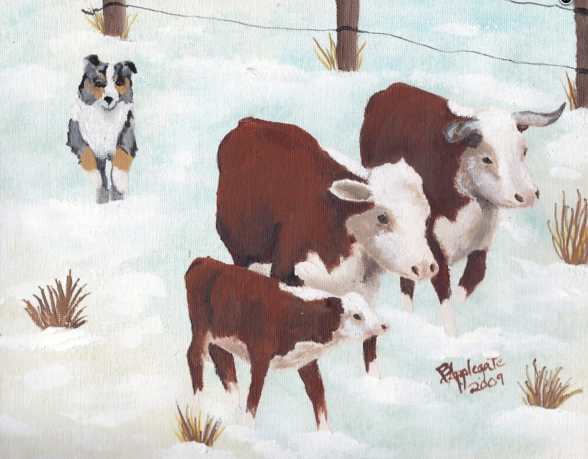
Oops. Blush. Sorry, our bad. We meant Head Dog. But we got your attention (and probably made some of you queasy) with our post title. Not all of you, however. Some of us like the cold cut terrine or meat jelly set in aspic and eaten cold or at room temperature. It’s what the stuff is made of that makes others run in the opposite direction…
….but we digress.
It is an adage in some dog training circles that when you control the head, you control the dog, and that’s the basic principal behind halti collars. Some herding dogs know this inherently when working stock, others can be trained to take control of the head to control cattle. These dogs, called “head dogs” or “fetch dogs,” are crucial when working cattle inclined to break away, or to keep a herd contained when being moved. Mind you, a head dog isn’t always appropriate in every situation; a dog that runs ahead at the same time that cattle are going through a gate or chute and turns them back isn’t helpful, but when a stockman is by him or herself and doesn’t have help, a head dog is valuable because when they control the head, they control the herd. It’s like a “natural fetch.” Cattle respect a dog threatening their head space, and they’ll move.
While the New Zealand Heading Dog may come to mind when talking about “head dogs,” we first came across the term in an article about Australian Shepherds. In essence, the article wrote of how different working scenarios compelled breeders to develop variations in working styles in different breeds, and the Aussie was developed to be a confident, authoritative, loose-eyed, close-working dog. An Aussie will only use grip to move reluctant or recalcitrant animal, and while he naturally grips at both the head and heel, many are trained to the head and gripping the nose or poll to turn an animal back to the herd. Indeed, the article claims that a large percentage of working Aussies are bred to work the head. We defer to herding experts in the breed on that point, but we thought it interesting enough to share. Ultimately, the breed’s savviness around stock, its power, agility and versatility makes it the go-to breed for many ranchers. It can work in pens and corrals, but also in a chute because Aussies aren’t intimidated in tight situations. In fact, the breed is highly regarded precisely for a superior ability to effectively manage livestock in tightly confined spaces.
Image: “First Snow” by Barbara Applegate is available for purchase as art, in accessories, and in home decor here
